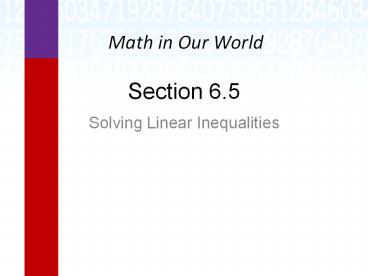Solving Linear Inequalities - PowerPoint PPT Presentation
Title:
Solving Linear Inequalities
Description:
Math in Our World Section 6.5 Solving Linear Inequalities Learning Objectives Graph solution sets for simple inequalities. Solve linear inequalities in one variable. – PowerPoint PPT presentation
Number of Views:505
Avg rating:3.0/5.0
Title: Solving Linear Inequalities
1
Section 6.5
Math in Our World
- Solving Linear Inequalities
2
Learning Objectives
- Graph solution sets for simple inequalities.
- Solve linear inequalities in one variable.
- Solve three-part linear inequalities.
- Solve real-world problems using inequalities.
3
Linear Inequalities
To solve a linear inequality means to find the
set of all numbers that make the inequality a
true statement when substituted in for the
variable. That set is called the solution set for
the inequality.
4
Graphing Inequalities
5
EXAMPLE 1 Graphing Solution Sets for Simple
Inequalities
- Graph the solution set for each inequality.
- (a) x 10 (b) y gt 4 (c) 30 lt x 50
6
Solving Linear Inequalities
7
EXAMPLE 2 Solving a Linear Inequality
- Solve and graph the solution set for 5x 9 21.
8
EXAMPLE 3 Solving a Linear Inequality
- Solve and graph the solution set for 16 3x gt 40.
9
EXAMPLE 4 Solving a Linear Inequality
- Solve and graph the solution set for
- 4(x 3) lt 2x 26.
10
EXAMPLE 5 Solving a Three-Part Linear
Inequality
- Solve and graph the solution set for 4 lt 3 2y
9.
11
Common Phrases in Inequalities
12
EXAMPLE 6 Applying Inequalities toVacation
Planning
- With the stress of finals behind you, you decide
to plan a vacation to relax a little bit. After
poking around on the Internet, you find a room in
the area you want to visit for 65 per night.
Some quick estimating leads you to conclude that
youll need at least 250 for gas, food,
beverages, and entertainment expenses. Upon
checking your bank balance, you decide that you
can afford to spend at most 600 on the trip. How
many nights can you stay?
13
EXAMPLE 7 Applying Inequalities to the Cost of
Buying Food
- Mike is planning to buy lunch for himself and
some coworkers. He decides to buy cheeseburgers
and fries from the value menuthe burgers are 1
each, and the fries cost 0.80. He also needs to
pay 5 of the total in sales tax. What is the
largest number of items he can buy if he wants to
buy the same number of burgers as fries, and he
only has 10 to spend?
14
Classwork
- p. 326-327 5-53 eoo, 63-71 odd































